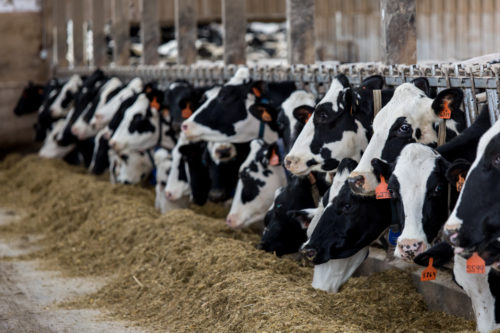Rumen Health During the Transition Period
Posted: May 5, 2022 | Written By: Dayane Da Silva, Ph.D., Form-A-Feed

Seventy-five percent of dairy cow health disorders such as displaced abomasum (DA), metritis, and retained placenta (RP) happen in the first 30 days of lactation. The onset of lactation puts tremendous metabolic stress on the dairy cow. The transition period, described as 21 days before calving and 21 days after calving, is one of the most critical times in the life of a dairy cow. A cow’s net energy demand for lactation increases overnight after calving. As a result, energy intake lags energy demands, and in general, cows experience negative energy balance (NEB) for 8-12 weeks after calving. However, during the period of NEB, cows will not quit producing milk! Instead, they will cope with the increase in energy requirement by mobilizing body fat, leading to increases in the blood circulation of non-esterified fatty acid (NEFA), glycerol, and Beta-Hydroxybutyrate (BHBA). However, excessive body fat mobilization can lead to fatty liver and has been linked to inflammation, which can negatively impact a cow’s immune function, well-being, and milk production.
This blog is focused on the rumen health of dairy cows during the transition period to maximize well-being and milk production. However, a good transition cow nutritional strategy for a successful healthy lactation should also focus on managing body condition scores and reducing inflammation to help cows overcome the hurdle of adjusting to their new energy demands.
Rumen health
Rumination or cud-chewing is a crucial indicator of dairy cow health. Cud chewing is essential for the breakdown of feed particles, increasing the surface area of feed and providing rumen microorganisms greater access to feed particles for a successful fermentation process. In turn, rumen microbes grow faster and offer greater yields of fat and protein building blocks for milk production. In addition, rumination stimulates saliva production and reduces the risk of rumen acidosis. Poor rumination, feeding, and lying behaviors have been associated with metabolic diseases. Being proactive and reinforcing rumen health during the transition period has helped farms to dictate the fate of the cow’s health and productivity for her entire lactation. Supplementation of direct fed microbials (DFM) during the transition period has been shown to speed up healthy bacteria growth in the rumen. Reaching rumination time greater than 550 minutes per day after calving as soon as possible decreases the chances of health events. On the other hand, less than 400 minutes per day has been linked to a high-risk factor for rumen acidosis. The University of Guelph has shown that rumen epithelium surface responds to the increase in microbial fermentation end-product by accelerating cellular proliferation to increase the surface area for volatile fatty acids (VFA) absorption. Greater VFA absorption in earlier lactation means less bodyfat mobilization and less inflammation. Gains of rumen papillae surface area at early lactation are remarkable, with increases in rumen mass by 55% between days 14 and 120 of lactation.
Feeding a DFM during the transition period keeps the rumen microflora active and ready for abrupt dietary changes. A healthy rumen means maximum nutrient utilization and greater feed efficiency, which is key to compensating for the reduced feed intake during the transition period. The longer the rumen takes to adapt to a lactating diet, the greater the chance a cow will not have adequate dry matter intake to fulfill energy requirements for milk production. In addition, the longer they will continue to mobilize fat and increase metabolic disease risk.
OTHER THINGS TO KEEP AN EYE ON DURING THE TRANSITION PERIOD:
- Rumination activity: Healthy cows should have rumination greater than 550 min/day
- Rumination will drop right before calving. Less than 400 minutes/day is considered low and is a significant indicator/risk factor for rumen acidosis.
- Body condition score (BCS): Keep BCS around 3.25 at calving.
- Over-conditioned cows have a greater circulating concentration of NEFA, glycerol, and ketone bodies and a higher risk of fatty liver.
- BHBA: The proportion of cows with BHB ≥ 1.2mmol/L during the first week of calving should be lower than 15%.
- Cow may develop subclinical (BHBA ≥ 1.2 and < 3.0 mmol/L) or clinical (BHBA ≥ 3.0 mmol/L) ketosis.
- Urine pH: should be kept at 5.5-6.5 before calving.